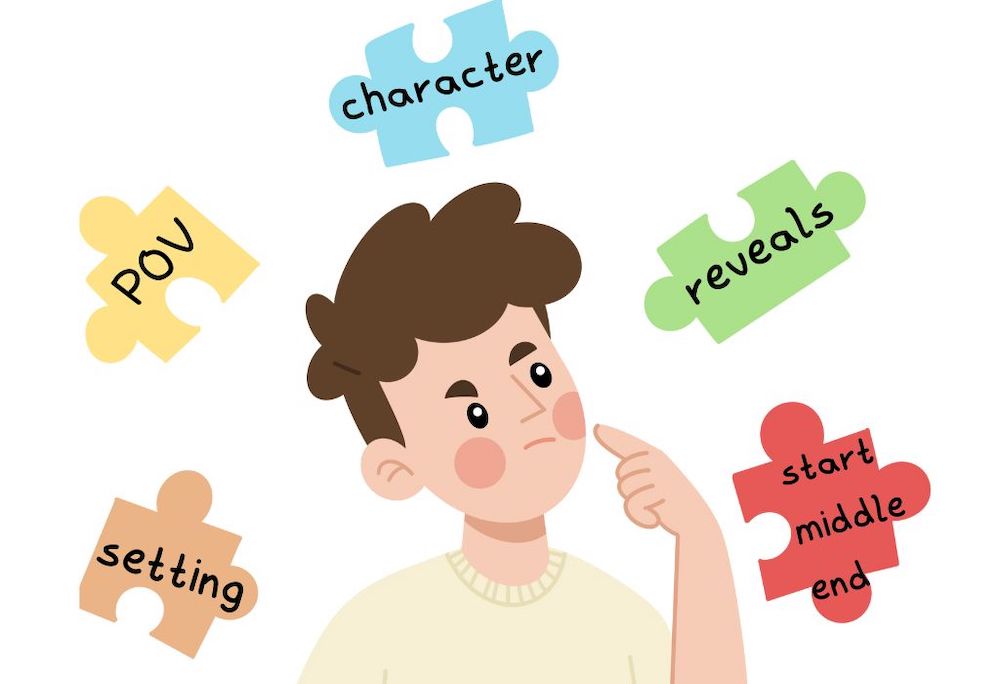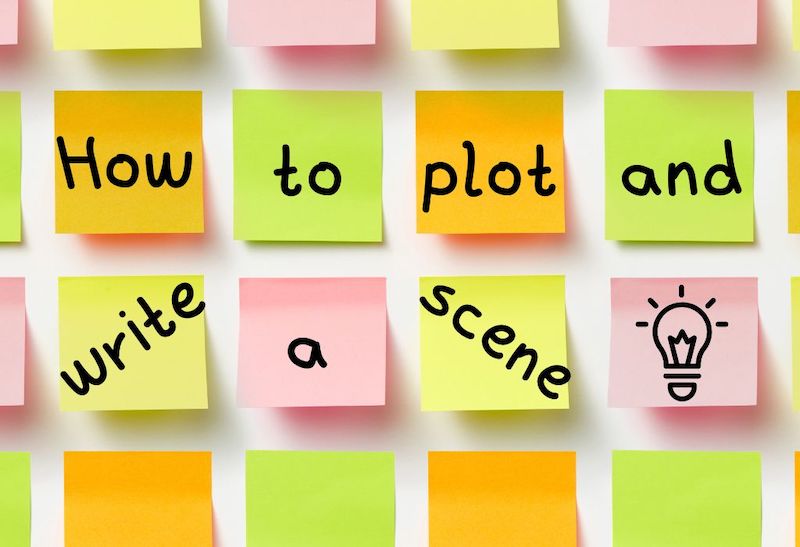Knowing how to plot and write a great scene is a crucial part of writing a novel. Scenes are the building blocks that hold up any book, fiction or non-fiction. (You can write a book without chapters; it’s much harder (arguably, impossible) to write one without scenes.) A bad scene will pull your reader out of the story, or worse, make them put your book down altogether. Conversely, a well-written scene will help your reader feel immersed in your book and eager to keep reading!
A common question many authors ask is how to plot and write a great scene. Read on to find out!
What is a scene?

A scene in a book should show a sequence of actions or events at a certain place and time (i.e., a setting).
You can tell when one scene ends and another begins when one or more the following change:
- location
- time
- narrative point-of-view (POV)
For example, a typical scene might open with your characters meeting in a particular location and end when they leave it. You might write a scene about two friends (a man and a woman) conversing in a coffee shop. The next scene might involve the same two friends, but they’ve since left the coffee shop and are now in the park. This change of setting (from coffee shop to park) marks the end of one scene and the beginning of the next.
This is also an example of how a shift in time can be used to indicate a switch from one scene to the next.
Finally, you could keep the action in the same time and place, but switch the perspective from one character (the man) to another (the woman). This, too, is a sign the scene has changed.
What makes a good scene?
Like baking a delicious cake, a good scene needs the right ingredients. Of course, it is possible to write a scene without these pointers. However, excluding them may make for a scene that fails to reach its potential.
A good scene:
- Moves the story forward. A character learns something and/or attempts to overcome an obstacle to their goals (successfully or not). Or, something happens that contributes to the overall plot.
- Reveals your characters’ motivations. This includes the emotions, wants/needs, goals, and the dilemmas they face. A good scene tells us something about a given character and who they are.
- Creates cause and effect. This can be something small, like foreshadowing clues about a twist that is revealed later. Or it could be something much bigger, like one scene where a character is mugged, leading to them becoming a recluse for the rest of the novel.
- Adds to the world-building. The reader learns more about the world by understanding its history, watching people using everyday objects, hearing about how different groups talk about and interact with each other, etc.
5 things to include in a scene

To give yourself the best chance of hitting all the points above, every scene should include the following 5 things:
- Setting. Establishing the time and place will help orientate your readers. This way they know where and when the events are taking place.
- POV. It should be evident from the start what point of view the scene is told from. If you are writing non-fiction or have a third-person omnipotent narrator, the point of view should already be obvious. For other narrator types, use showing (not telling) to establish who is the POV character as early as possible. Avoid switching POVs in the middle of a scene as this can confuse the reader.
- Character development. Each scene should reveal something about your characters and give your reader a deeper understanding of them. Hint: just because a character wants something at the start of the book, it might not be what they need as the story develops and they discover their true selves.
- Subtle reveals. You don’t want to info-dump on your reader, so be careful about revealing too much information in a single scene. Aim for a few reveals sprinkled throughout the scene. Always prioritise showing actions and emotions as opposed to telling the reader what’s happening. Trust yourself that you will reveal information at the right time, and trust your readers that they will keep up.
- Beginning, middle, and end. A scene is like a tiny story within your bigger one, so it needs a beginning, middle, and an end. The beginning should establish your setting and the characters within it. The middle should reveal the primary action driving the scene. The end should conclude the action or provide a bridge into the next scene if the action is ongoing.
Plotting a great scene
Outlining your book is a great way to ensure you stay on track with your plot, and it’s no different for a scene. However, mapping out a scene looks a little differently as you plot on a smaller scale. Here are a few tips to help you write a scene outline:
- Create a scene summary. Firstly, summarise your scene in a single paragraph. Look at it as a short synopsis, but for a single or short series of moments instead of your entire book. Be sure to include the setting, which characters will be present, and the overarching goal of the scene. (Note for pantsers: if creating a scene outline or summary feels too overwhelming, write the scene first. Then, go back and create your summary or outline any changes you need to make to the scene. This will help you to have a clearer understanding of what you do or don’t need to change.)
- Set a clear goal. You should have a single clear goal for your scene. For example: Nick learns more about the mysterious Jay Gatsby at one of his infamous all-night parties. If you can’t summarise the goal in a single sentence, the scene might be too complicated for the average reader to follow.
- Create plot points. Take your summary and break it into action-based plot points to show how your characters go from A to B throughout it. Remember, action doesn’t necessarily mean big set pieces or even a physical act. It could be learning or recalling something, for instance.
- Tease out your plot points. Add details to each plot point, such as dialogue ideas, quirks or behaviours to make your characters more believable, and setting descriptions.
What if I’m still struggling to write the scene?

As Jodi Picoult famously said, “You can always edit a bad page. You can’t edit a blank page.” So, if you feel you’re struggling with a scene, do your best to get something down, move on, then come back to it later. If that’s still too tricky, then write a placeholder summary of what you want to happen in the scene, move past it, and come back later. Maybe you’ll feel inspired after writing the rest of the book!
If neither of these approaches work and inspiration simply isn’t coming, it might be that something about the scene isn’t sitting right with you. In these cases, we recommend going back to the previous scene, chapter, or point in the book to change things. It may be a character has behaved in a way that isn’t consistent with the rest of the book, or perhaps they make a different choice. This will have a butterfly effect that often will either inspire you to write that tricky scene or to avoid/change it altogether.
If you’ve tried all these tips and you’re still having trouble, then maybe we can help. With our developmental editing or author coaching services, we can work with you to understand everything from the plot and characters to your intentions for specific moments, then help you resolve any issues and craft the perfect scenes.


